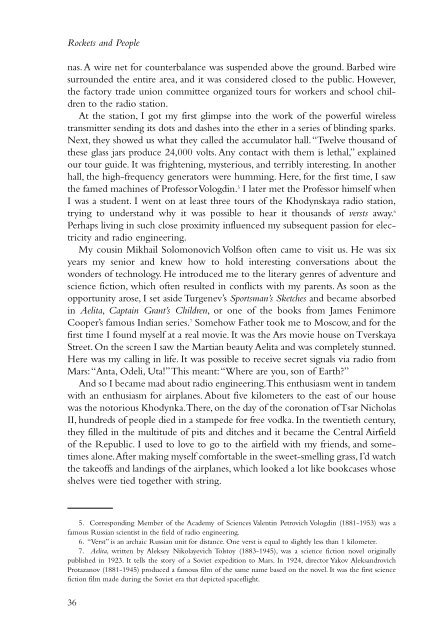to open next chapter. - NASA's History Office
to open next chapter. - NASA's History Office
to open next chapter. - NASA's History Office
You also want an ePaper? Increase the reach of your titles
YUMPU automatically turns print PDFs into web optimized ePapers that Google loves.
Rockets and People<br />
nas.A wire net for counterbalance was suspended above the ground. Barbed wire<br />
surrounded the entire area, and it was considered closed <strong>to</strong> the public. However,<br />
the fac<strong>to</strong>ry trade union committee organized <strong>to</strong>urs for workers and school children<br />
<strong>to</strong> the radio station.<br />
At the station, I got my first glimpse in<strong>to</strong> the work of the powerful wireless<br />
transmitter sending its dots and dashes in<strong>to</strong> the ether in a series of blinding sparks.<br />
Next, they showed us what they called the accumula<strong>to</strong>r hall.“Twelve thousand of<br />
these glass jars produce 24,000 volts. Any contact with them is lethal,” explained<br />
our <strong>to</strong>ur guide. It was frightening, mysterious, and terribly interesting. In another<br />
hall, the high-frequency genera<strong>to</strong>rs were humming. Here, for the first time, I saw<br />
the famed machines of Professor Vologdin. 5 I later met the Professor himself when<br />
I was a student. I went on at least three <strong>to</strong>urs of the Khodynskaya radio station,<br />
trying <strong>to</strong> understand why it was possible <strong>to</strong> hear it thousands of versts away. 6<br />
Perhaps living in such close proximity influenced my subsequent passion for electricity<br />
and radio engineering.<br />
My cousin Mikhail Solomonovich Volfson often came <strong>to</strong> visit us. He was six<br />
years my senior and knew how <strong>to</strong> hold interesting conversations about the<br />
wonders of technology. He introduced me <strong>to</strong> the literary genres of adventure and<br />
science fiction, which often resulted in conflicts with my parents. As soon as the<br />
opportunity arose, I set aside Turgenev’s Sportsman’s Sketches and became absorbed<br />
in Aelita, Captain Grant’s Children, or one of the books from James Fenimore<br />
Cooper’s famous Indian series. 7 Somehow Father <strong>to</strong>ok me <strong>to</strong> Moscow, and for the<br />
first time I found myself at a real movie. It was the Ars movie house on Tverskaya<br />
Street. On the screen I saw the Martian beauty Aelita and was completely stunned.<br />
Here was my calling in life. It was possible <strong>to</strong> receive secret signals via radio from<br />
Mars:“Anta, Odeli, Uta!”This meant:“Where are you, son of Earth?”<br />
And so I became mad about radio engineering.This enthusiasm went in tandem<br />
with an enthusiasm for airplanes. About five kilometers <strong>to</strong> the east of our house<br />
was the no<strong>to</strong>rious Khodynka.There, on the day of the coronation of Tsar Nicholas<br />
II, hundreds of people died in a stampede for free vodka. In the twentieth century,<br />
they filled in the multitude of pits and ditches and it became the Central Airfield<br />
of the Republic. I used <strong>to</strong> love <strong>to</strong> go <strong>to</strong> the airfield with my friends, and sometimes<br />
alone.After making myself comfortable in the sweet-smelling grass, I’d watch<br />
the takeoffs and landings of the airplanes, which looked a lot like bookcases whose<br />
shelves were tied <strong>to</strong>gether with string.<br />
5. Corresponding Member of the Academy of Sciences Valentin Petrovich Vologdin (1881-1953) was a<br />
famous Russian scientist in the field of radio engineering.<br />
6. “Verst” is an archaic Russian unit for distance. One verst is equal <strong>to</strong> slightly less than 1 kilometer.<br />
7. Aelita, written by Aleksey Nikolayevich Tols<strong>to</strong>y (1883-1945), was a science fiction novel originally<br />
published in 1923. It tells the s<strong>to</strong>ry of a Soviet expedition <strong>to</strong> Mars. In 1924, direc<strong>to</strong>r Yakov Aleksandrovich<br />
Protazanov (1881-1945) produced a famous film of the same name based on the novel. It was the first science<br />
fiction film made during the Soviet era that depicted spaceflight.<br />
36
















